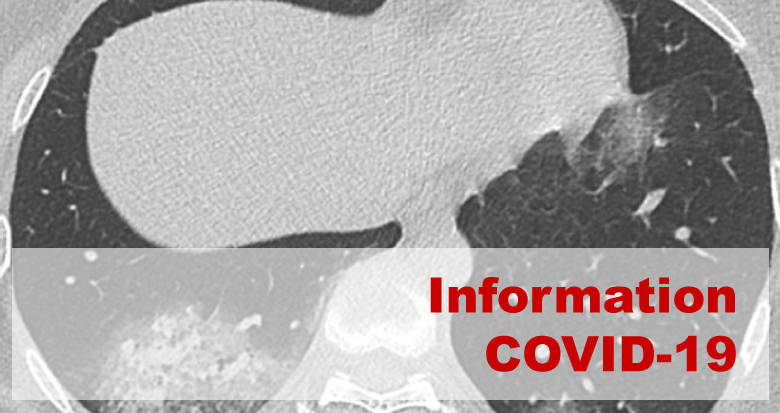WEB Seminar relatant l’expérience des hôpitaux de Singapour en radiologie interventionnelle face au COVID-19
Severe Acute Respiratory Syndrome Coronavirus 2 (SARS-CoV-2) is a novel Coronavirus that has quickly spread across the globe causing Coronavirus disease 2019 (COVID-19), with cases rapidly increasing in the United States. On March 11, 2020, the World Health Organization (WHO) declared COVID-19 a global pandemic. Given the importance of protecting healthcare workers during the pandemic, the SIR is releasing information and guidance for Interventional Radiologists to plan for the management of COVID-19 patients. This is a rapidly changing situation, and information will be updated as new information is released.
The average incubation period is currently estimated to be 5-6 days, with 97.5% of patients presenting with symptoms within 11.5 days of exposure1–3. Currently, 80% of cases are considered mild to moderate based on a WHO study of the initial outbreak in China2. However, the same study demonstrated a 21.9% crude fatality ratio (CFR) in laboratory confirmed cases in those 80 year of age or older, and a 3.8% CFR in confirmed cases overall. Patients with pre- existing medical conditions such as cardiovascular disease (13.2% CFR), diabetes (9.2% CFR), hypertension (8.4% CFR), and respiratory disease (8.0% CFR) also had a higher mortality risk. In addition, healthcare providers (HCP) remain at significant risk of developing COVID-19, with 1,716 providers becoming infected out of over 72,000 patients in China as of February 11, 20204. More recent estimates are over 3,000 HCP5. However, many of these cases occurred early in the outbreak, and infection to HCP can be reduced or eliminated with adoption of recommended precautions5–7. Thus, it is clear that the high-risk groups are elderly, those with certain pre-existing medical conditions, and healthcare providers. Planning should therefore take these factors into consideration.
There is no available data for the role of IR in management of COVID-19 patients and persons under investigation (PUI). Nonetheless, IR has a critical role in the management of patients within the healthcare system, and could conceivably be called to assist in the management of a COVID-19 positive patient. IR suites may also be located near radiology services where COVID- 19 patients may undergo imaging. Proper, and early, preparation is therefore crucial to reduce exposure to health care workers and other patients in IR.
Planning:
- Regardless of the number of COVID-19 patients at the facility, we recommend immediate plans be put in place to screen and/or manage COVID-19 patients
- We recommend IR teams be involved with their local COVID-19 response teams, or equivalent. Early involvement can help to streamline the flow of patients and minimize unnecessary patient and healthcare provider exposure.
- Develop plans with guidance from local resources, including infection control
- Emphasize to staff and visitors that CDC recommendations to protect yourself and others must be followed
- Staffing models should be discussed to take into account minimizing exposures and working with reduced staffing
Personal Protective Equipment (PPE):
- Refer to CDC and and WHO guidelines for appropriate use of PPE and ensure local policy is followed
- Conservation of PPE through training and appropriate use is critical during the COVID- 19 pandemic as the CDC is reporting “increased volume of orders and challenges in meeting order demands”
- Advice on mask use and hygiene outside and within the healthcare setting is described by WHO
Based on CDC guidance as of March 15, 2020 (https://www.cdc.gov/coronavirus/2019- ncov/hcp/caring-for-patients.html), the following recommendations are being made in the pre- procedure setting which incorporate CDC recommendations, including infection prevention in the healthcare setting:
|
A. Geographic Areas Currently Identified as Low Risk |
|
|
Outpatient Centers and Outpatient Based Labs (OBL) |
|
|
Inpatient |
|
|
|
|
|
B. Geographic Areas Currently Identified as Minimal to Moderate Risk |
|
|
Outpatient Centers and Outpatient Based Labs (OBL) |
|
|
Inpatient |
|
|
|
|
|
C. Geographic Areas Currently Identified as Substantial Risk |
|
|
Outpatient Centers and Outpatient Based Labs (OBL) |
|
|
Inpatient |
|
Resources:
WHO:
COVID-19 Situation Dashboard – updates on number of cases and locations Rational use of PPE for COVID-19
Q&A on infection prevention and control for health care workers caring for patients with suspected or confirmed 2019-nCoV
CDC:
Print/Poster Resources for COVID-19
Interim Infection Prevention and Control Recommendations for Patients with Suspected or Confirmed Coronavirus Disease 2019 (COVID-19) in Healthcare Settings
Interim US Guidance for Risk Assessment and Public Health Management of Persons with Potential Coronavirus Disease 2019 (COVID-19) Exposures: Geographic Risk and Contacts of Laboratory-confirmed Cases
Implementation of Mitigation Strategies for Communities with Local COVID-19 Transmission What Healthcare Personnel Should Know about Caring for Patients with Confirmed or Possible COVID-19 Infection
EPA:
COVID-19 Maps:
JHU COVID-19 Map
References:
- Lauer, S. A. et al. The Incubation Period of Coronavirus Disease 2019 (COVID-19) From Publicly Reported Confirmed Cases: Estimation and Application. Ann. Intern. Med. (2020) doi:10.7326/M20-0504.
- World Health Organization. Report of the WHO-China Joint Mission on Coronavirus Disease 2019 (COVID-19). (2020).
- Ng, Y. et al. Evaluation of the Effectiveness of Surveillance and Containment Measures for the First 100 Patients with COVID-19 in Singapore — January 2–February 29, 2020. MMWR Morb. Mortal. Wkly. Rep. 69, (2020).
- The Novel Coronavirus Pneumonia Emergency Response Epidemiology Team. The Epidemiological Characteristics of an Outbreak of 2019 Novel Coronavirus Diseases (COVID-19) — China, 2020[J]. China CDC Weekly 2, 113–122.
- Adams, J. G. & Walls, R. M. Supporting the Health Care Workforce During the COVID-19 Global Epidemic. JAMA (2020) doi:10.1001/jama.2020.3972.
- Cheng, V. C. C. et al. Escalating infection control response to the rapidly evolving epidemiology of the Coronavirus disease 2019 (COVID-19) due to SARS-CoV-2 in Hong Kong. Infect. Control Hosp. Epidemiol. 1–24 (2020) doi:10.1017/ice.2020.58.
- Schwartz, J., King, C.-C. & Yen, M.-Y. Protecting Health Care Workers during the COVID-19 Coronavirus Outbreak –Lessons from Taiwan’s SARS response. Clin. Infect. Dis. ciaa255 (2020) doi:10.1093/cid/ciaa255.


